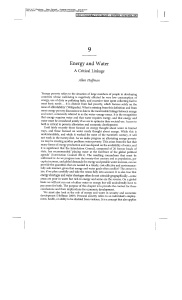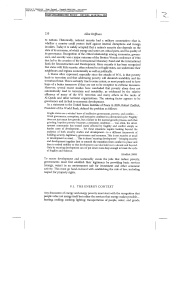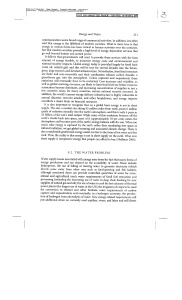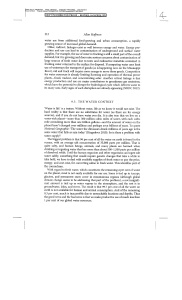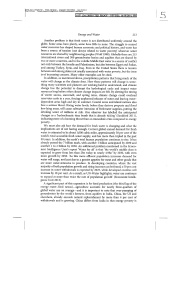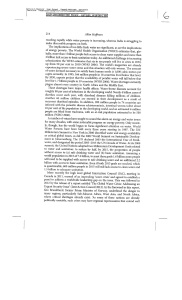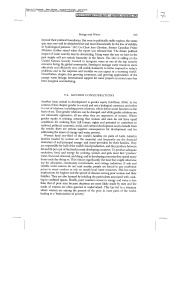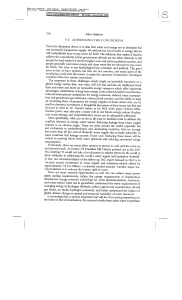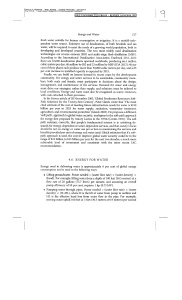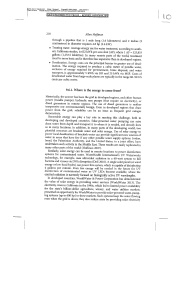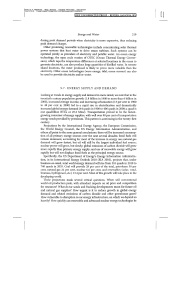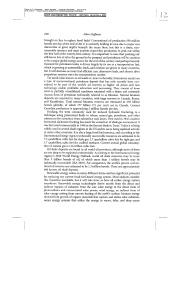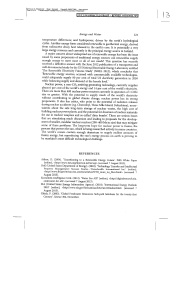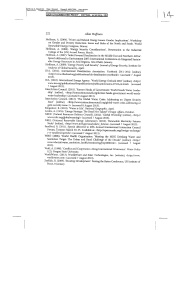‘Sun Towards High Noon: Solar Power Transforming Our Energy Future’ will be published in paperback by Pan Stanford Publishing on March 22nd. It will be listed at $34.95 but a 30% discount is available along with free shipping when ordered online at www.crcpress.com (Promo Code STA01). The latest volume in the Pan Stanford Series on Renewable Energy, it was edited by Dr. Peter F. Varadi, a solar energy pioneer and author of an earlier volume in the series ‘Sun Above the Horizon: Meteoric Rise of the Solar Industry’ (see below). Peter is also a contributing author in this new volume, along with Wolfgang Palz, Michael Eckhart, Paula Mints, Bill Rever, John Wolgromuth, Frank Wouters, and Allan Hoffman.
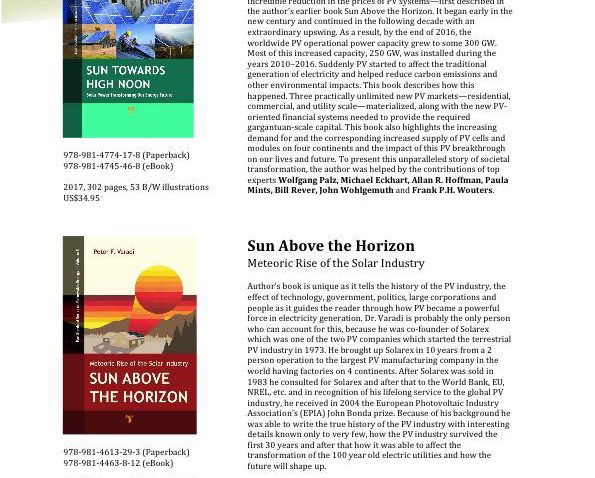
The broad scope and comprehensiveness of the book can be seen in its detailed Table of Contents reproduced below:
1. Meteoric Rise of PV Continues 1
1.1 Sun above the Horizon 2
1.2 Sun towards High Noon 6
2. New PV Markets Sustaining Mass Production 9
2.1 Utilization of the Terrestrial Solar Electricity 10
2.2 Solar Roofs for Residential Homes 13
2.3 Grids, Mini-Grids, and Community Solar 24
2.4 Commercial PV Systems 32
2.5 Utility-Scale Solar 43
2.5.1 Current Status 47
2.5.1.1 Concentrating solar power systems 47
2.5.1.2 Concentrating photovoltaic systems 50
2.5.1.3 Flat-plate photovoltaic systems:
fixed and tracking 51
2.5.2 Future Prospects 54
2.6 Important Large Market: Solar Energy and
Clean Water 56
2.6.1 Desalination and Disinfection: Introduction 56
2.6.2 Desalination 56
2.6.3 Disinfection 62
2.6.4 Conclusion 63
2.7 Quality and Reliability of PV Systems 64
2.7.1 Module Qualification Testing 65
2.7.2 Module Safety Certification 67
2.7.3 Module Warranties 68
2.7.4 Failure Rates in PV Systems 70
2.7.5 Module Durability Data 71
2.7.6 ISO 9000 72
2.7.7 IECQ and IECEE 72
2.7.8 To Further Improve Long-Term Performance 73
2.7.9 International PV Quality Assurance Task Force 75
2.8 Storage of Electrical Energy 83
2.8.1 Introduction 83
2.8.2 Why Is Electrical Energy Storage Important? 83
2.8.3 What Are the Various Forms of Electric Storage? 85
2.8.4 Applications of Energy Storage and Their Value 92
2.8.5 Capital Costs of Energy Storage 93
2.8.6 Concluding Remarks 94
2.9 Solar Energy and Jobs 95
2.9.1 Introduction 95
2.9.2 What Are the Facts? 95
2.9.3 Concluding Remarks 100
3. Financing 101
3.1 Financing of PV 102
3.2 Subsidies and Solar Energy 104
3.2.1 Introduction 104
3.2.2 What Forms Do Energy Subsidies Take? 104
3.2.3 What Is the History of US Energy Subsidies? 105
3.2.4 What Has All This Meant for Solar PV? 108
3.2.5 Concluding Remarks 110
3.3 Wall Street and Financing 111
3.3.1 Policy Drivers for Solar Energy Financing 111
3.3.1.1 The importance of policy to financing 113
3.3.2 Federal Policies 114
3.3.2.1 Federal RD&D 114
3.3.2.2 Public Utility Regulatory Policies Act 117
3.3.2.3 Investment tax credits 118
3.3.2.4 Commercialization and deployment 120
3.3.2.5 Government purchasing 122
3.3.3 State and Local Policies 123
3.3.3.1 Renewable Portfolio Standards and RECs 123
3.3.3.2 Solar Set-Asides and SRECS 123
3.3.3.3 Net energy metering 124
3.3.3.4 Leading state examples 124
3.3.4 International Policy for Solar Energy Financing125
3.3.4.1 Policies of individual governments 126
3.3.4.2 International agencies 129
3.3.4.3 Multi-lateral development banks 131
3.3.4.4 Impact of NGOs on government policy 132
3.4 Solar Market Segmentation and Financing Methods 136
3.4.1 Utility-Scale Solar Project Financing 136
3.4.2 Commercial & Institutional Rooftop Financing 136
3.4.3 Community Solar 137
3.4.4 Residential Rooftop Financing 137
3.4.4.1 PPA model 138
3.4.4.2 Inverted lease 138
3.4.4.3 Loan-to-ownership 139
3.5 Solar Project Financing 140
3.5.1 Traditional Power Generation Financing 140
3.5.2 PURPA and the Development of Non-Recourse
Financing 140
3.5.3 Conditions Required for Project Financing 142
3.5.4 Overall Capital Structure: Equity, Tax
Equity, and Debt 143
3.5.5 Tax Equity Using the Investment Tax Credit 144
3.5.6 Bank Loans 145
3.5.7 Institutional Capital 146
3.5.8 Project Bonds 147
3.6 Capital Market Investment in Solar Securities 148
3.6.1 Equity Market Investment in Solar Companies 148
3.6.2 Yieldcos and Other Portfolio Companies and
Funds 150
3.6.3 Green Bonds 153
3.6.4 Securitization 155
3.7 Summary 157
3.8 Glossary 158
4. Present and Future PV Markets 161
4.1 The Global View of PV 162
4.2 The Present and Future of Neglected PV Markets:
Africa and the Middle East 164
4.2.1 Introduction 164
4.2.2 Africa 166
4.2.3 Middle East and North Africa 183
4.3 The Present and Future Market in the Americas 192
4.3.1 The United States of America 194
4.3.2 Canada 204
4.3.3 Countries in Latin America 205
4.4 The Present and Future Market in Europe 208
4.5 The Present and Future Markets in Asia 220
4.6 The Present and Future Markets in Australia
and in Oceania 231
4.7 Global Community Unites to Advance Renewable
Energy: IRENA 236
4.7.1 Start of IRENA 238
4.7.2 Hermann Scheer
4.7.3 IRENA’s Roots and Early Days 241
4.7.4 Institutional Setup 246
4.7.5 Hub, Voice, Resource 247
4.7.6 IRENA’s work 248
4.7.7 The Way Forward 252
4.7.8 Glossary 254
5. The Impact of Solar Electricity 255
5.1 The Impact of Solar Electricity 256
5.2 In the Twilight of Big Oil, in Retrospect, PV Was
a Missed Boat 259
5.3 PV and the Brave New World of the Electric Utilities 267
6. Outlook to the Future 281
About the Contributors 291
Index 295
The value of this new book is captured in the two back cover comments:
“This comprehensive and timely book provides the reader with a very thorough technical, regulatory, and financial overview of the global solar (PV) industry. Featuring internationally eminent contributors from the who’s who of solar industry experts, this book offers insights, analysis, and background on all the key issues facing this rapidly growing industry. It will be an invaluable reference and resource for scholars, investors, and policymakers dealing with the emerging solar power phenomenon.” (Branko Terzic, Atlantic Council, Former Commissioner/U.S. Federal Energy Regulatory Commission)
“The long-term welfare of people on our planet depends on an energy system heavily dependent on solar energy. This solar energy handbook presents a well-documented, comprehensive, and insightful view of solar energy’s past, present, and future. Its preeminent contributing authors include solar energy pioneers, visionaries, and practitioners who bring a wealth of experience and insights into solar energy markets, financing, policy, and technology.” (Karl R. Rabago, Executive Director/Pace Energy and Climate Center, Elisabeth Haub School of Law, Pace University)


